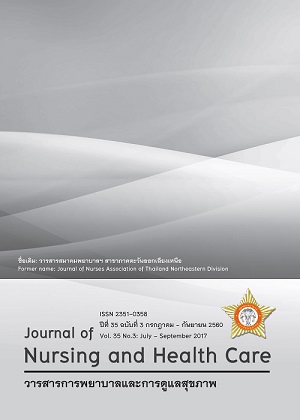ประสิทธิผลของรูปแบบการพยาบาลผู้ป่วยที่มีภาวะติดเชื้อในกระแสโลหิต The Effectiveness of Nursing Care Model for Sepsis Patients
คำสำคัญ:
แนวปฏิบัติทางการพยาบาล, รูปแบบการดูแลทางการพยาบาล, ภาวะติดเชื้อในกระแสโลหิต, ภาวะช็อกจากการติดเชื้อ Nursing Care Model, Sepsis, Severe Sepsis, Septic shockบทคัดย่อ
บทคัดย่อ
การศึกษาครั้งนี้เป็นการวิจัยเชิงปฏิบัติการ มีวัตถุประสงค์เพื่อพัฒนารูปแบบการพยาบาลผู้ป่วยที่มีภาวะติดเชื้อในกระแสโลหิตในแผนกอุบัติเหตุและฉุกเฉินโรงพยาบาลราชวิถี กลุ่มผู้ร่วมวิจัย คือ ผู้ป่วยที่มีภาวะติดเชื้อในกระแสโลหิตที่รับรักษาไว้ในโรงพยาบาลราชวิถี จำนวน 56 คน และพยาบาลวิชาชีพผู้ปฏิบัติงาน 20 คน การดำเนินการวิจัยเริ่มตั้งแต่เดือนตุลาคม พ.ศ. 2558 ถึง มิถุนายน พ.ศ. 2560 โดยแบ่งการศึกษาเป็น 3ระยะ ดังนี้ ระยะที่ 1 การศึกษาวิเคราะห์สถานการณ์ โดยการทบทวนเวชระเบียน และทำการสัมภาษณ์เชิงลึกพยาบาลวิชาชีพประจำแผนกอุบัติเหตุและฉุกเฉินที่มีประสบการณ์ 2 ปี ขึ้นไป ระยะที่ 2 การพัฒนารูปแบบการพยาบาลผู้ป่วยที่มีภาวะติดเชื้อในกระแสโลหิต ระยะที่ 3การประเมินประสิทธิผลของการใช้รูปแบบการพยาบาลผู้ป่วยที่มีภาวะติดเชื้อในกระแสโลหิตในแผนกอุบัติเหตุและฉุกเฉิน โดยประเมินผลลัพธ์ต่อผู้ป่วยได้แก่ 1) ระยะ เวลาที่ได้รับยาปฏิชีวนะ ภายใน 60 นาที ตั้งแต่ผู้ป่วยมาถึงจุดคัดกรอง 2) อัตราตายของผู้ป่วยที่มีภาวะติดเชื้อในกระแสโลหิตลดลง ผลลัพธ์ต่อผู้ใช้รูปแบบการพยาบาลผู้ป่วยที่มีภาวะติดเชื้อในกระแสโลหิต ได้แก่ ความพึงพอใจของพยาบาลวิชาชีพ เครื่องมือในการวิจัย คือ 1) รูปแบบการพยาบาลผู้ป่วยที่มีภาวะติดเชื้อในกระแสโลหิตที่ผู้วิจัยพัฒนาขึ้น 1.1) แนวปฏิบัติการใช้รูปแบบการพยาบาลผู้ป่วยที่มีภาวะติดเชื้อในกระแสโลหิต 1.2) ใบคัดกรองและแผนการรักษาผู้ป่วยที่มีภาวะติดเชื้อในกระแสโลหิตแบบใหม่ ให้สามารถดักจับอาการของผู้ป่วยที่มีภาวะติดเชื้อในกระแสโลหิตได้ทันเวลา และส่งต่อเข้าระบบ Fast Tract Sepsis 1.3) คู่มือการพยาบาลผู้ป่วยที่มีภาวะติดเชื้อในกระแสโลหิต และ 2) แบบประเมินความพึงพอใจของพยาบาล วิเคราะห์ข้อมูลเชิงปริมาณ ใช้การแจกแจงความถี่ ร้อยละ ค่าเฉลี่ย และส่วนเบี่ยงเบนมาตรฐาน เปรียบเทียบผลลัพธ์ก่อนและหลังพัฒนารูปแบบการพยาบาลผู้ป่วยที่มีภาวะติดเชื้อในกระแสโลหิตโดยใช้สถิติ Mann-Whitney U Test และChi-square และการวิเคราะห์ข้อมูลเชิงคุณภาพ โดยการวิเคราะห์เชิงเนื้อหา
ผลการวิจัยทำให้ได้แนวปฏิบัติของพยาบาลที่ร่วมกับทีมสหสาขาวิชาชีพในการดูแลผู้ป่วยที่มีภาวะติดเชื้อในกระแสโลหิตโดยการปรับระบบการคัดกรองให้ถูกต้อง รวดเร็วและเข้าระบบ Fast Tract Sepsis เกิดผลลัพธ์ที่ดีต่อผู้ป่วย ได้แก่ ระยะเวลาที่ได้รับยาปฏิชีวนะตั้งแต่ผู้ป่วยมาถึงจุดคัดกรองเร็วขึ้นจาก131นาทีเป็น 41นาที ระยะเวลาที่ผู้ป่วยได้รับสารน้ำทดแทนเร็วขึ้นจาก 68 นาที เป็น 9 นาที และ ระยะเวลาการส่งสิ่งส่งตรวจทางห้องปฏิบัติการเร็วขึ้นจาก 100 นาที เป็น 26 นาที อัตราตายลดลงจากร้อยละ 61.1 เป็นร้อยละ 25 และพยาบาลวิชาชีพมีความพึงพอใจในภาพรวมต่อรูปแบบการดูแลผู้ป่วยที่มีภาวะติดเชื้อในกระแสโลหิตอยู่ในระดับสูง
สรุปได้ว่าการพัฒนารูปแบบการคัดกรองให้ดักจับอาการได้ทันเวลาและเข้าระบบ Fast Tract Sepsis ทำให้เกิดรูปแบบการพยาบาลผู้ป่วยอย่างต่อเนื่อง มีการประสานงานความร่วมมือกับสหสาขาวิชาชีพ ช่วยลดอัตราการตาย และพยาบาลวิชาชีพผู้ใช้รูปแบบมีความพึงพอใจ ข้อเสนอแนะควรมีการพัฒนาต่อเนื่องจนถึงหอผู้ป่วยในเพื่อให้การดูแลผู้ป่วยที่มีภาวะติดเชื้อในกระแสโลหิตมีประสิทธิภาพยิ่งขึ้น
Abstract
This action research aimed to develop a nursing care model for sepsis patients in Emergency Medicine Department of Rajavithi Hospital. The participants were 56 patients with sepsis and 20 registered nurses in Emergency Medicine Department, Rajavithi Hospital. The study was divided into three steps including; step 1: situation analysis by reviewing patient’s medical records and in-depth interview registered nurses working in Emergency Medicine Department more than two years; step 2: developing a nursing care model for Sepsis Patients; and step 3: evaluation a nursing care model before and after the study. Research instruments consisted of two parts. The first part was a nursing care model for sepsis patients developing by the research team consisting of 1) a practice guideline according to nursing care model for sepsis patients; 2) the screening form that early identification and treatment of patients with sepsis; and 3) manual of nursing care for sepsis patients. The other part of research instrument was nurse satisfaction. Quantitative data was analyzed by using descriptive statistics; frequency, percentage, mean, standard deviation, and comparing the results between before and after developing model. Mann-Whitney U Test and Chi-square were also analyzed. Moreover, qualitative data from emergency nurses were analyzed by content analysis.
The sepsis practice guidelines for nurses worked together with multidisciplinary team were initiated during developing process. Results of study reveal better patient outcomes, such as duration time of receiving antibiotic therapy since patient arriving were shorter than those, from 131minutes to 41minutes. The time of intravenous fluid replacement was becoming shorter, from 68 minutes to 9 minutes. Blood testing was also done shorter, from 100 minutes to 26 minutes. The death rate was also decreased from 61.1 % to 25%. Furthermore, the overall of nurse satisfaction toward nursing care model for Sepsis Patients were high.
In conclusion, developing sepsis screenings that collaborate with multidisciplinary have been shown to be highly effective in early identification and treatment of patients with sepsis continuously. Moreover, nurses were more satisfied with using nursing care model for sepsis patients. Suggestion, nursing care system for sepsis patients should be continuously developed hospitalized patients among in-patient department setting.



